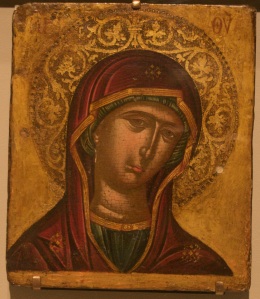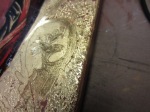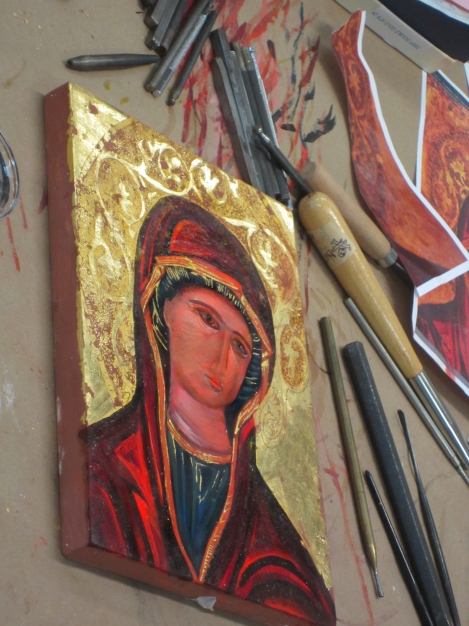
Head of the Virgin.
Emmanuel Tzanès (Greek, active by 1636–died 1690).
Tempera on wood, gold ground.
8 3/8 x 7 1/8 in. (21.3 x 18.1 cm).
Gift of Mrs. Henry Morgenthau, 1933.
Accession no: 33.79.15
[Image credit: RBWeisenmiler]
Head of the Virgin (detail of face). Emmanuel Tzanès. [Image credit: pompanon.fr]
I then drew out my design and gilt around it, extending a small amount over the figure’s outline so that there would be an overlap.
After grounding, gilding, and drawing, the next step was to begin painting with our newly ground pigments.
We made sure to purchase organic cage-free eggs, as Cennini expresses some concern about the color of the egg yolks used: Eggs had to be fresh and supplies of both country eggs and town eggs were needed. The “country” eggs were supposedly redder and better suited to the making of darker colors, and the “town” eggs were whiter and better suited to light colors. Cennini also suggests that town eggs are more suitable for painting young, smooth faces, while country eggs were better for painting old men with ruddy complexions.
The color of egg yolk results from the natural pigments consumed by the hens. So, if the difference in color between “town” eggs, “country” eggs or “organic, cage-free” eggs is due to chicken diet, the type of egg used may indeed create an appreciable difference in the final effect. (Thank you to my classmate Annika Finne for her research on egg yolk composition.)
At first I was not very successful at mixing the egg together with the pigments in the right proportion. Painting with tempera was very also very challenging, as the medium dried extremely quickly. The longer I did it, however the more accustomed to its properties I became.
After I painted, I made a punched pattern on the gilded background. Below are photos of the punches I used.
- Round punch
To create the pattern, I free-handed the vegetal design with a needle-like tool, stippled a pattern in-between the vines, and then burnished the vines to create a contrasting surface quality. Because the clay below the gold leafing was too dry, the gold flaked off when I punched in the small dots. I found this to be acceptable, however, as it does imitate the patina on the original panel.
- The vine pattern scratched into the gold with a needle
- Stippling added in the interstices
I also added “mordant” or “oil” gilding into the highlighted areas of the Virgin’s robes, and her hair. This involved the application of a sticky, brand mordant with a very small brush. I then patted the gold leaf over the areas to be gilt and waited for the oil to dry, before brushing the excess away.
- Mordant visible before application of gold leaf
- The gold leaf drying before the excess is brushed away
When I patted the gold down, I think that the oil feathered out a bit, resulting in thicker lines than I intended. Also, the oil took a very long time to dry!
But when I brushed off the extra leaf, I was relatively satisfied with the results.
~~~
Finally, here is the most recent full view (with an incomplete halo) of my reproduction of the panel by Emmanuel Tzanès:
I had a great time learning and applying all of these techniques, reading Cennino Cennini, and setting a little time aside in my busy schedule for painting. The whole process was very rewarding!
Stay tuned for updates on my classmates’ panels!
Thank you for reading, and have a happy New Year,
~Kate Brugioni











